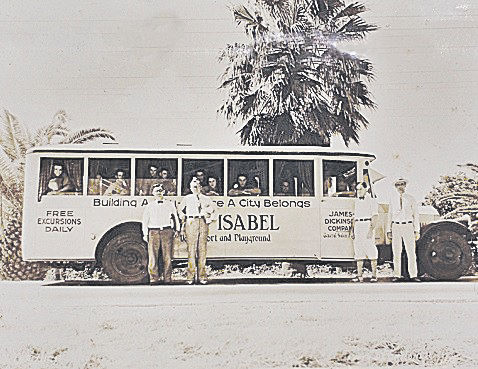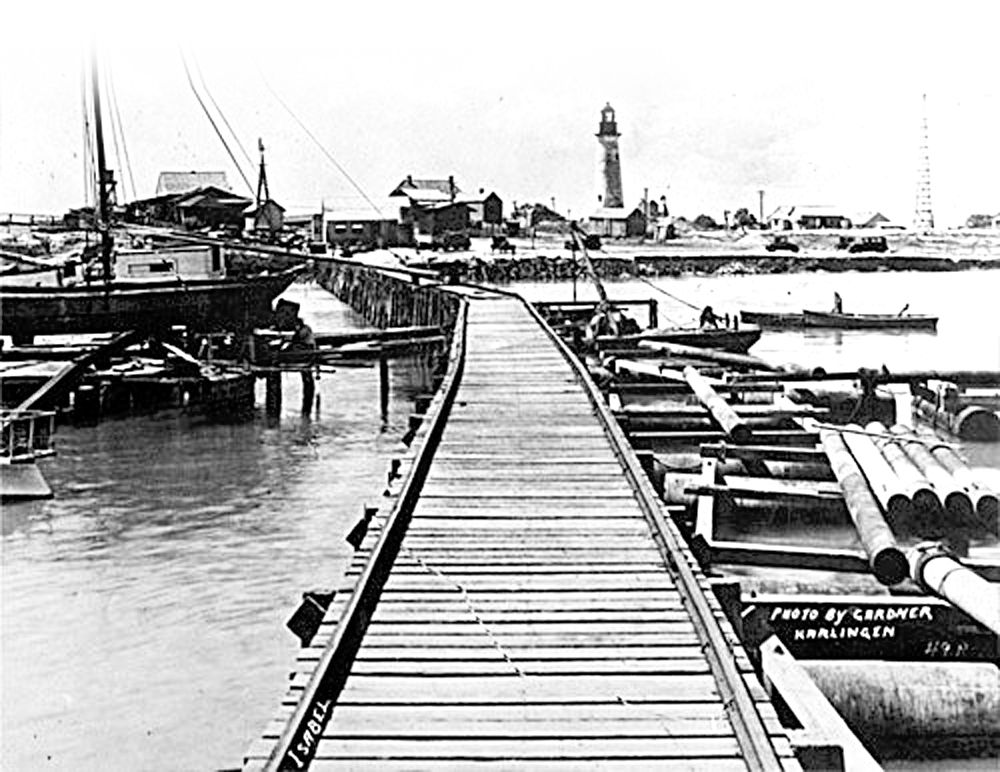BY NORMAN ROZEFF
3/23/28 — Point Isabel is officially incorporated as Port Isabel.
11/1928 — The first edition of the Port Isabel Pilot weekly newspaper is published.
12/29/28 — The Port Isabel and San Benito Navigation District is created by election and authorized to issue $500,000 in bonds. These were issued as of May 1, 1929 and sold.
1/22/30 — Plans for a $1 million causeway linking Port Isabel and Padre Island are revealed.
6/21/30 — The Port Bill passes in the U.S. Congress. $2,158,000 are appropriated for a Valley Deep Water Port and a survey to extend the intra-coastal waterway from Corpus Christi to Port Isabel, the Sabine Pass, Texas to Corpus Christi having been completed.
6/25/30 — The contract is awarded to complete the remaining 11.4 miles of HWY 100. The award is to R.W. Briggs & Company, Pharr. Its bid was $245,000.
8/1/30 — The name of the town was officially changed to Port Isabel from Point Isabel although a second source indicates that this occurred on February 1.
11/5/30 — The Port Isabel Corporation runs a full page ad in the Port Isabel Pilot. It details the corporations subsidiaries and its finances.
12/17/30 — The last section of the paving of State Highway 100 is completed. The concrete pour began August 16, 1930.
3/25/31 — John H. Shary of Mission & Sharyland buys the private Port Isabel Yacht Club and opens it to the public.
The Alta Vista Apartments were constructed in 1931 for the Gaskill-Hodgson Company. This Mediterranean Mission Style structure is the oldest apartment building in Port Isabel.
A survivor of numerous coastal storms and hurricanes, the complex originally consisted of three each one-bedroom, two-bedroom, and efficiency apartments.
Prominent features of the two-story stucco building include its asymmetrical massing, arched-entry porches, covered balconies, courtyard,and red tile roof. It was purchased in 1985 by the Beckers, Reynolds, and Mrs. Lehman in 1985. It received a Texas Historical Commission marker in 1988.
The apartments are located behind the Yacht Club, itself situated on what was once called Taylor’s Hill.
The idea for a deep-water port was promoted in the autumn of 1911 when Dr. S. K. Hallam helped to organize the Brownsville Waterways Association. Its goal was to provide the Valley the advantages of water transportation.
This objective brought many of the area’s leading citizens into the fold. Initial efforts met no success with the Army Corps of Engineers. Initial local revenue raising of $125,000 allowed the start of dredging in August 1923.
At one point the dredges Mollie, Leona Scudds, and Velasco operated opposite the Rio Grande Railroad Wharf. When more funds were required as the amount of material to be moved was considerably greater than estimated, the dredging ceased in January 1925.
The Federal government was committed to the project however. Two jetties were added to the project. Work was first to begin on the transfer wharfs on July 22, 1926 and by June 29, 1927 the two dikes were completed. The actual cost had risen to $206,341. A trestle had to be constructed across the Laguna Madre as well as rail along the south end of Padre Island to allow the rail transportation of the giant rocks comprising the jetties.
The very first major ship to traverse the Brazos Santiago new jetty pass did so around 7/28/35 when the 4,150 gross ton steamer Freeport moved on to Port Isabel. Owned by the Waterman Steam Ship Company of Mobile, she was piloted into the dock by A. L. Kelly with Capt. K.R. Duncan in command. The 200’ long by 30 ‘beam ship was crewed by 27 merchantmen. Its cargo destined for Mobile would be 80,000 to 100,00 bushels of shelled corn contracted by Banks L. Miller.
Commercial shipping to and from Port Isabel would be greatly diminished when Browns ville expedited the rights of land and dredging the 17 miles from deep water to what would become the Port of Brownsville. The official dedication of the port would be on May 10, 1936.
In the Brownsville Herald of 5/10/36 upon the opening of the jetty channel to Port Brownsville, Elisa Costa Neda Villareal wrote these remarks.
“On 1/24/1828 Rafael Garcia was given a grant of land of 30,000 acres from the state of Tamaulipas. A narrow peninsula in the grant called ‘El Fronton de Santa Ysabel’ extended into the Laguna Madre. When the Americans came, they translated the name and called the place ‘Point Isabel’. In that way the town that was to become the most important port in South Texas was named.” Port Isabel today is renowned for its tourism, fine eating establishments, famed shrimping fleet, renewed port activities, senor retirement facilities, museums, winning high school football team, a restored Bahia Grande, and much more, including its timeless lighthouse structure.





